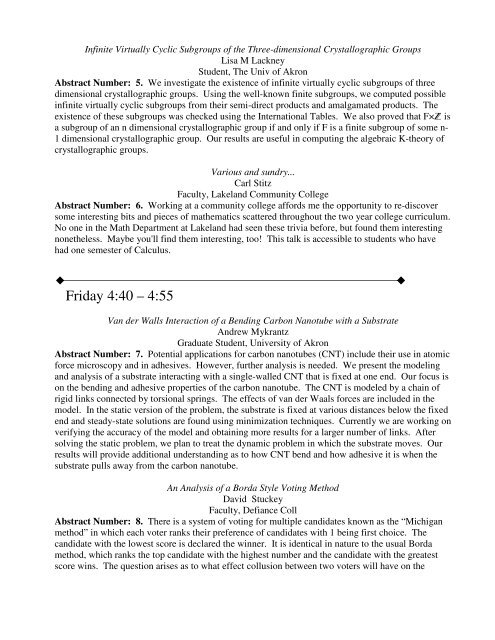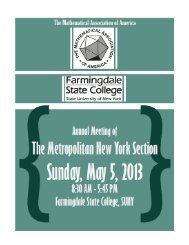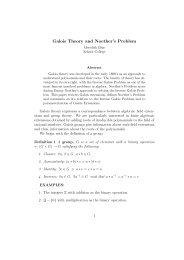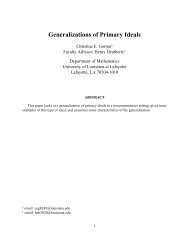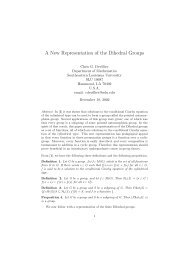Program - MAA Sections - Mathematical Association of America
Program - MAA Sections - Mathematical Association of America
Program - MAA Sections - Mathematical Association of America
You also want an ePaper? Increase the reach of your titles
YUMPU automatically turns print PDFs into web optimized ePapers that Google loves.
Infinite Virtually Cyclic Subgroups <strong>of</strong> the Three-dimensional Crystallographic Groups<br />
Lisa M Lackney<br />
Student, The Univ <strong>of</strong> Akron<br />
Abstract Number: 5. We investigate the existence <strong>of</strong> infinite virtually cyclic subgroups <strong>of</strong> three<br />
dimensional crystallographic groups. Using the well-known finite subgroups, we computed possible<br />
infinite virtually cyclic subgroups from their semi-direct products and amalgamated products. The<br />
existence <strong>of</strong> these subgroups was checked using the International Tables. We also proved that F× is<br />
a subgroup <strong>of</strong> an n dimensional crystallographic group if and only if F is a finite subgroup <strong>of</strong> some n-<br />
1 dimensional crystallographic group. Our results are useful in computing the algebraic K-theory <strong>of</strong><br />
crystallographic groups.<br />
Various and sundry...<br />
Carl Stitz<br />
Faculty, Lakeland Community College<br />
Abstract Number: 6. Working at a community college affords me the opportunity to re-discover<br />
some interesting bits and pieces <strong>of</strong> mathematics scattered throughout the two year college curriculum.<br />
No one in the Math Department at Lakeland had seen these trivia before, but found them interesting<br />
nonetheless. Maybe you'll find them interesting, too! This talk is accessible to students who have<br />
had one semester <strong>of</strong> Calculus.<br />
Friday 4:40 – 4:55<br />
Van der Walls Interaction <strong>of</strong> a Bending Carbon Nanotube with a Substrate<br />
Andrew Mykrantz<br />
Graduate Student, University <strong>of</strong> Akron<br />
Abstract Number: 7. Potential applications for carbon nanotubes (CNT) include their use in atomic<br />
force microscopy and in adhesives. However, further analysis is needed. We present the modeling<br />
and analysis <strong>of</strong> a substrate interacting with a single-walled CNT that is fixed at one end. Our focus is<br />
on the bending and adhesive properties <strong>of</strong> the carbon nanotube. The CNT is modeled by a chain <strong>of</strong><br />
rigid links connected by torsional springs. The effects <strong>of</strong> van der Waals forces are included in the<br />
model. In the static version <strong>of</strong> the problem, the substrate is fixed at various distances below the fixed<br />
end and steady-state solutions are found using minimization techniques. Currently we are working on<br />
verifying the accuracy <strong>of</strong> the model and obtaining more results for a larger number <strong>of</strong> links. After<br />
solving the static problem, we plan to treat the dynamic problem in which the substrate moves. Our<br />
results will provide additional understanding as to how CNT bend and how adhesive it is when the<br />
substrate pulls away from the carbon nanotube.<br />
An Analysis <strong>of</strong> a Borda Style Voting Method<br />
David Stuckey<br />
Faculty, Defiance Coll<br />
Abstract Number: 8. There is a system <strong>of</strong> voting for multiple candidates known as the “Michigan<br />
method” in which each voter ranks their preference <strong>of</strong> candidates with 1 being first choice. The<br />
candidate with the lowest score is declared the winner. It is identical in nature to the usual Borda<br />
method, which ranks the top candidate with the highest number and the candidate with the greatest<br />
score wins. The question arises as to what effect collusion between two voters will have on the


